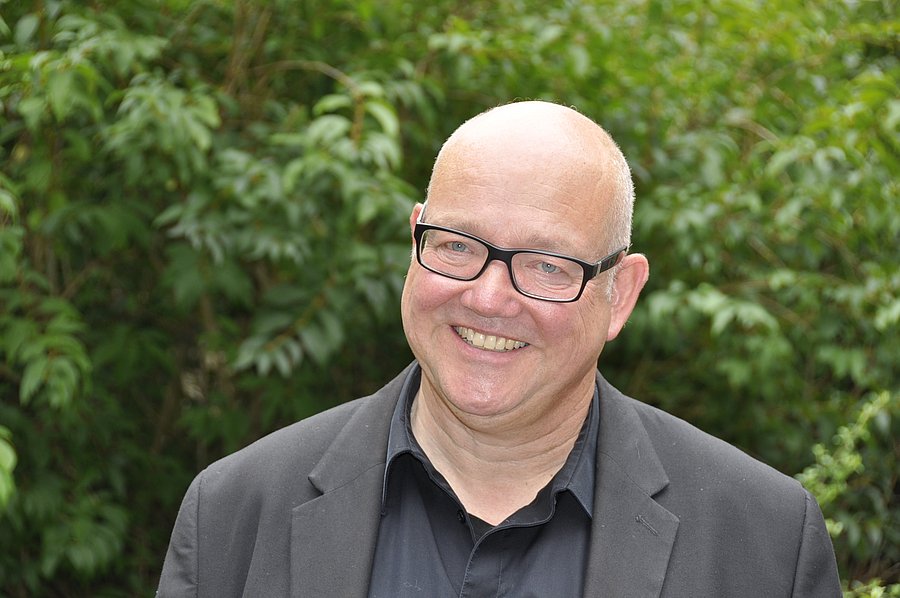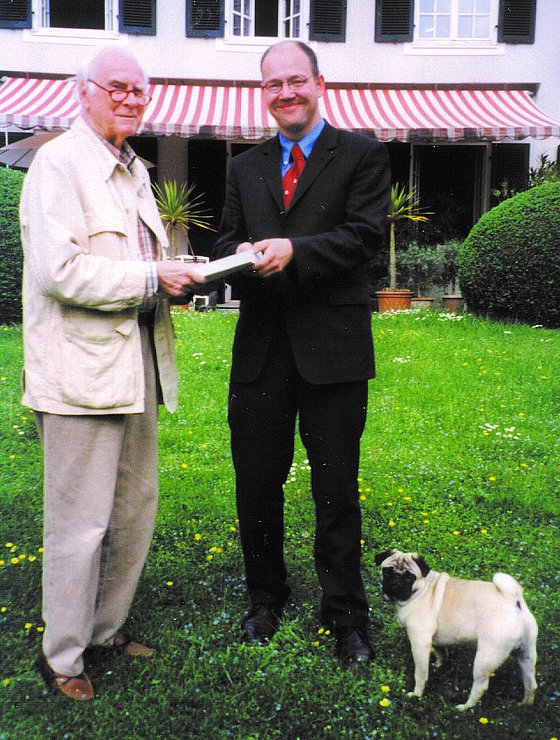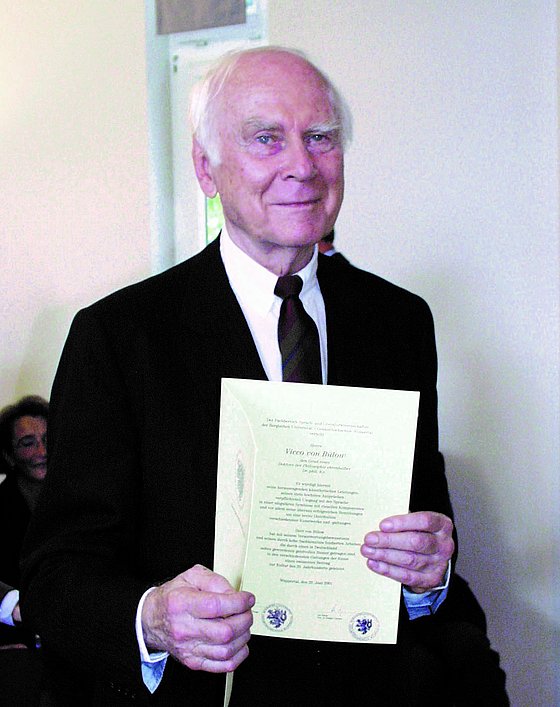
100th birthday of Loriot
Dr. Stefan Neumann / German Studies
Photo: UniService Transfer
Loriot: The proven connoisseur of West German sensitivities
Dr. Stefan Neumann on the 100th birthday of Vicco von Bülow
What do you spontaneously think of when you hear the name 'Loriot'?
Neumann: Oh no! (Loriot often used this interjection in his sketches in a laconic way to enhance the comedy of the situation; his exclamation Ach (was)! has become common knowledge. Editor's note).
Loriot, whose real name was Bernhard-Viktor "Vicco" Christoph-Carl von Bülow, would have turned 100 on November 12. He was a versatile all-rounder. How can you recognize that?
Neumann: You can sum it up in a very simple formula. Loriot didn't follow trends, he made them. That applies to his early career as a cartoonist as well as to his career as a television and film director. His humor is unique. He changed things and reinvented them. Loriot is subtle, sophisticated and exposing, without exposing his characters or his audience. He draws on his life experience, close observation of his fellow human beings and, of course, his craftsmanship and precision in timing, staging and delivery. Even the props are very detailed and lovingly made. Loriot's comedy is based on the fear that the bourgeois world will collapse, that you yourself will be left unprotected and a failure. Like the boss of Vereinigte Europa-Trikotagen GmbH, who tries to start a relationship with his secretary, but fails at the very physics of a kiss, and whose desperate "Others do it too" can be applied to many things. Loriot's comedy is complex. And that is why it is often ambiguous. We understand it immediately and laugh, but when we ask what exactly is so funny, it becomes difficult. Loriot's comedy is art on a high level. He worked very meticulously, and he was very demanding of his employees, but always humanly humorous, a very affable person.
What does the name Loriot actually mean?
Neumann: Vicco von Bülow studied art in Hamburg and actually wanted to become a visual artist. On the side, so to speak, the newly married Loriot earned his living with graphics and humor drawings for newspapers. And he didn't want to give away his name for this bread and butter job. So he took the heraldic bird of the von Bülow family, an oriole, and translated the name of this bird into French, because at that time French cartoonists were very successful. That's how Loriot came about.
Loriot was actually a trained painter and graphic artist. One of his first drawings was a figure that is still well-known today and which he often used as a commercial artist in the magazine "Stern". Which figure is this?
Neumann: Almost everyone knows the famous bulbous-nosed man. It's a stylized male figure with a big nose, usually dressed in the Stresemann, the state-supporting suit from the 1920s, in which high aspirations and treacherous failure are already united in the person. When I see the Knollnasenmännchen in front of me with his incredulously astonished, somewhat enraptured facial expression and these clothes, which were already old-fashioned in the 1950s, I always think: Oh well! The outside and the inside of this figure contradict each other and one can recognize oneself in it very well.
But the Germans had to get used to his humor. There were also protests, and Stern even ended its collaboration with him. For what reason?
Neumann: Loriot pushed boundaries again and again during his career. This began with his first major cartoon series, in which he exchanged the roles of people and dogs, a classic "topsy-turvy world" motif, but one that seemed outrageous to people in the 1950s: In one drawing, you see a young woman with several children in a basket. Around the basket is a shocked looking family of large dogs, one of whom says, ""You just shouldn't have let her out of your sight for a minute."" This did not go down well in the society of prudish sexual morals and the idea of man as the crown of creation. There were baskets of angry letters to the editor and "Stern" did not print any more cartoons by Loriot for almost 20 years, with the exception of a children's supplement in which he was allowed to continue drawing Reinhold the rhinoceros to given texts. In the late 1960s, Loriot then showed naked people for the first time on German television in his ARD television series "Cartoon". Even then, there were people who didn't find that funny. But the more famous Loriot became and the more liberalized West German society became, the better the relationship became.
No one wanted to publish his drawings. But that changed with the Diogenes publishing house. Why?
Neumann: Daniel Keel, the publisher of the freshly founded Diogenes Verlag, was young, eager to experiment and knew how to combine popular culture with artistic standards. That's why Loriot was right at home there. He had been made aware of the publishing house by an acquaintance and thus came into contact with Keel. Keel's series of small gift books, which were sold in station bookstores and gift stores, were an ideal medium for the early Loriot drawings. Unlike "Stern," Keel dared to publish outside the mainstream. Loriot then remained with this publishing house throughout his life.
In the 1970s, he created what is probably his best-known dog. Who was that?
Neumann: Wum was the mascot of Aktion Sorgenkind, which Loriot had drawn. Aktion Sorgenkind was a television lottery whose proceeds were intended to support the victims of the thalidomide scandal at the time. In a little cartoon sketch, drawn and spoken by Loriot, Wum referred to the TV lottery show, which was called "3 times 9" and later renamed "The Big Prize". There were also other characters like Wendelin the elephant and Blue Klaus. The showmaster's name was Wim Thoelke, hence the name Wum. Wum quickly became the darling of the nation and the highlight of the respective TV show, in each of which a sketch was embedded in which Wum did some pretty crazy things. For children, this was an absolute highlight of the television week and they begged to be allowed to stay up until Wum was shown. At that time, I was also infected by the Loriot virus as a child. Later there was even a hit song with Wum's singing called "Ich wünsch mir `ne kleine Miezekatze..." which reached number 1 in the music charts.
Loriot was involved in early film productions as an actor, e.g. in Bernhard Wicki's 'Die Brücke', but only made himself immortal among viewers through his own television series and subsequent films from the 1970s onwards. Above all, his sketch series 'Loriot,' which he presented with six episodes, still have cult status today. What makes them so special?
Neumann: The classics that are still in the nation's memory today are above all the sketches he produced in Loriot I to VI in the years between 1976 and 1978. Everything was just right here. The liberal 1970s allowed many things that would have been impossible before. At Radio Bremen, no one talked Loriot into it, and he had a first-class ensemble. Above all, of course, Evelyn Hamann. This is where classics such as "Der Lottogewinner", "Das Jodeldiplom", "Die Nudel" and many others were created. Loriot's craftsmanship with his visual imagination and his extraordinary feeling for language play into each other's hands. If you want to understand this time, the West German affluent society with its warning of environmental destruction, which Loriot clearly warned about at the time, and the West German self-image between megalomania and uptightness, you have to watch Loriot. He is a master of his craft and a proven expert on the sensitivities of his time.
What many people don't know is that he was also active in the field of opera.
Neumann: There was a great affinity for opera ever since his childhood, which he spent with his grandmother and great-aunt when his parents separated. The two ladies always took him to the opera as a reward, and he loved that from an early age. He is also considered a great Wagner fan. At first he wrote intermediate texts for operas, e.g. in 1975 for Saint-Saen's 'Carnival of the Animals', in 1982 for 'Peter and the Wolf'. Later, he wrote explanatory texts for operas at gala concerts at Munich's Gärtnerplatz. This was well received, because his texts were also very funny and the operas were better understood as a result, because he explained the connections easily and humorously. His friend, the opera director Klaus Schulz, persuaded him for a long time until he finally took over a production. That was first the opera 'Martha` by Flotow at the end of the 1980s and then the 'Freischütz` by Weber, both of which were great successes.

Vicco von Bülow with Stefan Neumann (2000)
Photo: Private
Mr. Neumann, Loriot was awarded an honorary doctorate from Bergische Universität in 2001. But you yourself also had personal encounters with him. How did that come about? Neumann: The idea for an honorary doctorate arose in the context of my research on Loriot, whom I had also met personally in the course of my research. When I was thinking about what dissertation topic I could choose, I had suggested to my doctoral advisor, Prof. Heinz Rölleke, whether I could do something on Loriot's linguistic and literary connection, and I was afraid he would throw me out eight-handed, because he was not known for dealing with popular science topics. But he thankfully allowed the topic. He was concerned with Loriot's linguistic creativity, his close listening. And so my research attracted a bit of attention and through the help of a dedicated honorary citizen of Bergische Universität, Mrs. Stella Baum, who knew Loriot personally, I was allowed to meet Mr. von Bülow and was able to do research on site at his home for a week. I was allowed to work in his archive, which was wonderful. He was also a very special contemporary.

Honorary doctorate for Vicco von Bülow (2001)
Photo: Petra Zöllner
So the idea of offering him an honorary doctorate solidified, because I was able to prove in my work that in fact, in the literary and linguistic field, he not only observed many things well and portrayed them masterfully. And this is evident not only in the drawings or sketches on the visual level, but even more so on the linguistic level. Rilke is countered with a silly rhyme, fussy business language with innuendo. Loriot sets a very elaborate code against the failure of language and he does it magnificently. We were very pleased that he accepted the honorary doctorate of the Bergische Universität in 2001.
Uwe Blass
Dr. Stefan Neumann works in the Faculty of Humanities and Cultural Studies at Bergische Universität in the area of Didactics of German Language and Literature.
